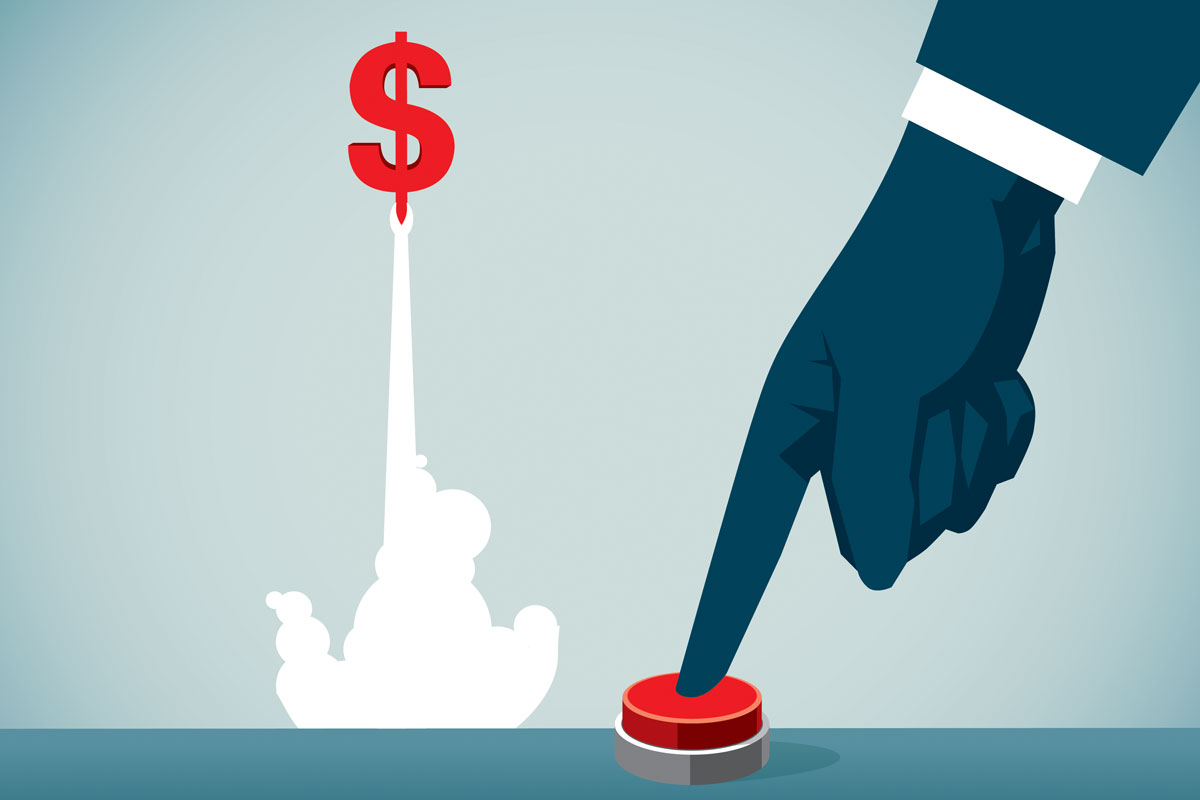Price Check
How to professionally propel your prices

Let’s face it: These days, businesses are expensive to run. With inflation rising, tariffs looming and laborers seeking higher wages, sometimes a business can feel like an endless money pit. That’s why reviewing financials and increasing prices are essential for a viable pool industry business.
“As a business owner, it’s important to have a pulse on the sustainability of the business, which is an ongoing process throughout the calendar year,” says Austin Gardiner, CEO of GL Pools in San Diego.
When companies provide value and offer professional services, prices reflect that.
“Sometimes [a price increase] needs to be done so companies can continue to survive, deliver high quality, pay their teams a livable wage and have the proper licensing, training and insurance,” Gardiner says. “Though it is scary to adjust rates, it’s much scarier to be making compromised decisions about safety or sustainability. Those sacrifices ultimately impact your clients by introducing risk and friction.”
If it’s been a while since you’ve raised prices, the time is now. And if that thought gives you anxiety, no need to fear — we’ve compiled a guide to help you raise your prices so you’re not leaving money on the table with every job.
Watch your bookkeeping
Not closely monitoring business transactions is a costly mistake, especially if a pool pro goes months without looking at the cost of goods.
Gardiner explains that when equipment manufacturers raise their prices, they immediately adjust their repair and installation rates for new quotes. However, when chemical prices rise, they wait until an equilibrium is reached before adjusting costs for existing service clients, ensuring pricing remains consistent and predictable for their budgets. For new service clients, the updated pricing takes effect right away, avoiding any near-term adjustments.
Rachael Pritz, vice president of RB Retail & Service Solutions, says too many pool pros don’t know the value of their services, which often hurts their financial decisions.
Assessing direct and indirect expenses, including labor, materials and overhead, is key to knowing where and when prices need to go up, Pritz says.
The low barrier to entry in the pool industry means an uneven playing field for businesses trying to make a profit, says Kyle Peter, owner of Sacramento-based Nevergreen Pools.
“Unfortunately, as an industry, we’re rather unsophisticated as businesspeople,” he says. “If you don’t know how business works, you don’t have a business. You’re not profitable.”
He adds that too many neglect bookkeeping, which is the first issue to consider when a company wants to increase pricing.
“Most folks don’t know their costs and expenses; they don’t know the real numbers,” Peter says.
Everyone, even down to the newest pool tech, knows the numbers at Nevergreen Pools. It keeps Peter accountable for paying a living wage while also confirming whether a price increase is warranted.
“[Our team] knows where our income is and how it compares to last year, our goals and our cost of goods sold,” he says. “I share the profit percentage every quarter.”
He advises all pool pros to be transparent about the numbers from management down to pool techs. Peter also recommends business owners read “Profit First” and use tools, like Google Sheets, to manage expenses.
“We also have calculators for everyone quoting jobs, whether it’s for weekly service or equipment repairs that you put your inputs in [labor and materials] and a required gross profit margin,” he says.

When to increase rates
After assessing financial health, business owners can consider a price increase.
One way to do that is ongoing tracking with apps and calculators. Nevergreen uses Skimmer to ensure the gross profit margin by customer is in line with expectations.
“We know all of our costs, and if the cost exceeds what we’re charging monthly, that’s a problem,” Peter says.
Raising rates is essential to reflect growing expertise, rising material costs and the value offered to clients. Maintaining sustainable rates ensures pros can continue delivering top-notch service without compromising a business’s future.
“We focus on making sure our team has the time and resources to deliver what our clients want, which is reliability and expertise,” Gardiner says. “We don’t put team members in situations where they have too many route stops for the day and would not have enough time to perform high-quality work.”
A price increase can be enacted after a competitive analysis and by looking at ways to add value to current service packages. Price increase in chemicals or manufacturing costs? It’s a must to pass that cost along to clients.
“We let our clients know how much we respect them, their budgets and financial pressure by never raising prices unless it’s necessary,” Gardiner says. “When rates need to change, we provide ample notice before the adjustment date and encourage open communication with any questions or feedback.”
For those who closely watch profit margins, a knee-jerk price increase won’t be necessary, either.
Gardiner points out that most manufacturers lock in pricing at the top of the season, so it’s smart to use that information to guide whether a price increase is warranted.
Be clear about rate increases
It’s safe to say that unexpected price increases can irritate customers, especially long-term ones.
One mistake pool pros make is increasing prices with no explanation.
“I don’t think there’s enough educating of the customer,” Pritz says. “Before you have a price increase, you need to justify it to your customer.”
Whether it’s higher labor costs, inflation or increased costs of fuel or chemicals, giving the “why” makes it easier for customers to handle. Another option: Onboard new clients at a higher price point, which is an opportunity to let existing ones know they’ll be at their current price for a limited time.
Pritz says giving a clear timeline helps customers adjust.
Some business software, including RB Retail & Service Solutions, allow pool pros to notify customers by email, text and even at the bottom of accounts receivable statements.
As for those longtime clients? They get a raise, too. Pritz says grandfathering in loyal clients is a “way to lose a lot of money.” She says with price increases “happening everywhere” that it isn’t uncalled for to raise rates.
Ultimately, it’s about ensuring customers have time to plan and adjust their budgets for the services that matter most to them. If a pool cleaning company is doing a great job, then it’s a no-brainer for customers to keep them in the budget.
Think about showcasing professional value
As the industry evolves and operational costs rise, pool pros must think beyond traditional pricing models. By demonstrating value, elevating customer service and aligning with sustainable practices, you can justify premium pricing while securing long-term stability.
That might mean charging new clients more than existing ones. Doing in-person estimates is one way to showcase that value, Peter says.
“We’re going to paint a picture of how it’s going to be a headache-free experience if they hire us and then we present the price,” he says.
Getting creative with add-ons and offering tiered services is another way to increase prices while also giving customer options.
“We focus on showing them our value at all times, so that they can consider the price in comparison to value, reliability and trust,” Gardiner says. “It’s our hope that when they weigh all those elements, they decide to choose us as their pool service provider.”
Ultimately, it’s about being a reputable, professional company, Gardiner says, and having open conversations with clients.
“One reality of most of the ‘cheaper’ pool companies we compete with: They can afford to be cheaper by providing less time and focus to their clients and their pools,” he says. “In some cases, cheaper competitors are also skimping on necessary chemicals. We aren’t willing to cut corners. If a price increase is needed due to chemical demands, we will take a deeper look and assess if there are ways the price increase could be avoided through good client communication about issues such as overheating a pool, overhanging trees, swimming dogs and other adjustments.”
Focus on what it truly costs to provide the level of service you’re committed to — not just what the market is charging. Many solo operators forget to include their own labor in their pricing. But your time has real value, and there’s always an opportunity cost. If you don’t account for it, you’re undervaluing your business.”
Austin Gardiner, GL Pools
Know the nerves are normal
If the idea of increasing your rates makes you uneasy, you’re not alone. In a competitive industry where customers can shop for cheaper services, it’s natural to feel hesitant.
But as Peter points out, many low-priced competitors are barely staying afloat — and often don’t last long. Unprofitable businesses may be covering salaries, but they’re dragging down the market for those who actually understand their numbers, he says.
Gardiner offers this tip for pushing past the hesitancy to raise prices: “Focus on what it truly costs to provide the level of service you’re committed to — not just what the market is charging. Many solo operators forget to include their own labor in their pricing. But your time has real value, and there’s always an opportunity cost. If you don’t account for it, you’re undervaluing your business.”






